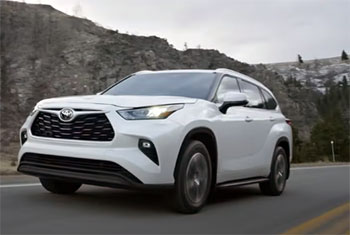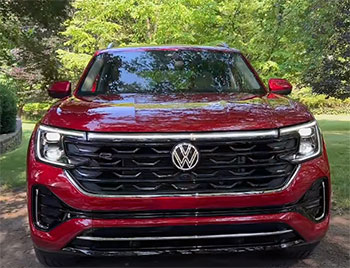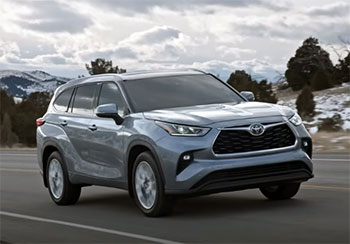I’ve spent countless hours behind the wheel of SUVs, hauling kids, groceries, and camping gear, so when it came time to compare the 2025 Toyota Highlander and Volkswagen Atlas, I approached it like a real-world test drive. My goal? To figure out which midsize SUV suits families, commuters, and adventurers like me—and maybe you.
This article breaks down their performance, space, tech, and value, weighing pros and cons to help you decide. From city streets to weekend getaways, I’ll share my take on what makes each shine or stumble, ensuring you get the full picture.
Comparison Table: Toyota Highlander vs. Volkswagen Atlas
| Feature | Toyota Highlander (2025) | Volkswagen Atlas (2025) |
|---|---|---|
| Starting MSRP | $41,815 | $39,625 |
| Engine | 2.4L Turbo 4-cylinder, 265 hp, 310 lb-ft | 2.0L Turbo 4-cylinder, 269 hp, 273 lb-ft |
| Fuel Economy (City/Hwy) | 22/29 MPG | 20/26 MPG |
| Seating Capacity | Up to 8 | Up to 7 |
| Cargo Space (Behind 3rd Row) | 16.0 cu. ft. | 20.6 cu. ft. |
| Max Cargo Space | 84.3 cu. ft. | 96.8 cu. ft. |
| Third-Row Legroom | 28.0 in. | 33.7 in. |
| Towing Capacity | 5,000 lbs (gas), 3,500 lbs (hybrid) | 5,000 lbs |
| Warranty | 3 years/36,000 miles (basic) | 4 years/50,000 miles (basic) |
| Reliability Rating | 8.9/10 (iSeeCars) | 5.7/10 (iSeeCars) |
| Safety Rating (NHTSA) | 5 stars | 5 stars |
My Experience With the Toyota Highlander

Driving the 2025 Toyota Highlander felt like slipping into a familiar pair of shoes—reliable, comfortable, but not flashy.
Its compact design made it a breeze to navigate tight city streets, and the 2.4-liter turbo four-cylinder engine delivered a smooth 265 horsepower.
I appreciated the pep it had merging onto highways, though it’s not going to win any drag races.
The cabin was quiet, with a polished feel, and the available hybrid option caught my eye for its fuel efficiency, hitting 36 MPG combined in some trims.
The Highlander’s interior screamed practicality. With seating for up to eight, it’s a solid pick for bigger families, though the third row is snug for adults—my 6-foot friend wasn’t thrilled back there.
The tech, like the 12.3-inch touchscreen on higher trims, was intuitive, and Toyota Safety Sense 3.0 (standard across all models) gave me peace of mind with features like adaptive cruise control and lane-keeping assist. Cargo space was decent but tighter than I’d hoped, especially with all seats up.
On a weekend trip, the Highlander handled light off-road trails with ease, thanks to its 8-inch ground clearance. However, I noticed the base trim felt a bit spartan, missing luxuries like heated seats that you’d need to upgrade for. Overall, it’s a dependable workhorse, but I wondered if it could match the Atlas’s bold presence.
Pros Of the Toyota Highlander
- Reliability is top-notch: Toyota’s reputation shines here, with an 8.9/10 reliability rating from iSeeCars, meaning fewer trips to the mechanic and more peace of mind for long-term ownership.
- Fuel efficiency stands out: The gas model gets 22/29 MPG (city/highway), and the hybrid option boosts that to 36 MPG combined, saving me noticeable cash at the pump.
- Seating for eight: Unlike the Atlas, the Highlander can fit an extra passenger, which was a game-changer when carpooling with my kids’ friends.
- Advanced safety suite: Toyota Safety Sense 3.0 comes standard, with adaptive cruise control, lane departure alerts, and automatic emergency braking—features I relied on during busy commutes.
- Resale value holds strong: Toyota’s won Kelley Blue Book’s Best Resale Value award multiple times, so I’d likely get a better return when selling compared to the Atlas.
- Hybrid option for eco-conscious drivers: The five hybrid trims offer a greener ride without sacrificing power, appealing to my eco-friendly side.
- Compact size for city driving: At 194.9 inches long, it’s easier to park in tight spots than the larger Atlas, a plus for urban dwellers like me.
Cons Of the Toyota Highlander
- Tight third-row space: The 28-inch third-row legroom felt cramped for adults, making it better suited for kids on long drives.
- Limited cargo space: With only 16.0 cubic feet behind the third row, I struggled to fit larger items like strollers without folding seats.
- Higher starting price: At $41,815, it’s pricier than the Atlas’s $39,625, which stung when I compared base model features.
- Base trim feels basic: Lacking standard heated seats or wireless charging, I had to consider pricier trims to get the creature comforts I wanted.
- Less engaging drive: The Highlander’s handling is smooth but uninspiring, lacking the sporty feel I got from the Atlas on twisty roads.
- Hybrid towing capacity drops: The hybrid’s 3,500-pound towing limit (vs. 5,000 pounds for gas) meant I couldn’t haul heavier gear without opting for a gas model.
- Interior feels less spacious: With 141.3 cubic feet of passenger volume, it’s noticeably tighter than the Atlas, especially for taller passengers.
My Experience With the Volkswagen Atlas

The 2025 Volkswagen Atlas felt like a bold statement on wheels.
Its larger frame (200.7 inches long) gave it a commanding road presence, and the 2.0-liter turbo engine, pumping out 269 horsepower, had a lively kick that made passing on highways a thrill.
The ride was smooth, with responsive steering that made it surprisingly agile for its size.
I took it on a family road trip, and the spacious cabin was a hit—everyone had room to stretch, especially in the third row.
Inside, the Atlas impressed with standard features like heated and ventilated front seats and a 12-inch touchscreen.
The IQ.Drive suite, standard across trims, added adaptive cruise control and blind-spot monitoring, which I found reassuring on busy roads.
Cargo space was a standout, with 20.6 cubic feet behind the third row—enough for my camping gear without folding seats. However, the Atlas’s fuel economy (20/26 MPG) was a letdown compared to the Highlander, and its reliability rating (5.7/10 from iSeeCars) gave me pause. Still, its roomy interior and fun drive made it a strong contender.
Pros Of the Volkswagen Atlas
- Spacious interior: With 153.7 cubic feet of passenger volume, the Atlas felt like a living room on wheels, especially for my taller passengers.
- Generous cargo capacity: Offering 20.6 cubic feet behind the third row and 96.8 cubic feet max, I easily packed for a weekend getaway without Tetris-level planning.
- Roomy third row: The 33.7 inches of third-row legroom meant adults could sit comfortably, a rarity in midsize SUVs.
- Lower starting price: At $39,625, it’s more budget-friendly than the Highlander, leaving room for upgrades or savings.
- Engaging driving dynamics: The turbo engine and responsive steering made driving fun, especially on winding roads where the Highlander felt sluggish.
- Standard luxury features: Heated/ventilated seats, wireless charging, and a 12-inch touchscreen come standard, making the base trim feel premium.
- Longer warranty: The 4-year/50,000-mile basic warranty beats the Highlander’s 3-year/36,000 miles, giving me extra confidence.
Read More: My Thoughts On Ford Escape Vs. Mazda CX-5
Cons Of the Volkswagen Atlas
- Lower fuel economy: At 20/26 MPG, I stopped at gas stations more often than with the Highlander, which hit my wallet harder.
- Questionable reliability: The 5.7/10 reliability rating from iSeeCars worried me about potential repair costs down the line.
- No hybrid option: Unlike the Highlander, the Atlas lacks a fuel-efficient hybrid, limiting options for eco-conscious buyers like me.
- Steeper depreciation: The Atlas loses 48.2% of its value over five years (vs. 39.2% for the Highlander), meaning a lower resale return.
- Bulky size: Its 200.7-inch length made parking in tight city spots trickier than with the more compact Highlander.
- Interior controls can frustrate: The lack of physical buttons for climate and audio settings forced me to dig through menus, which was distracting.
- Higher trims get pricey: While the base model is affordable, top trims like the SEL Premium R-Line climb to $55,865, outpacing Highlander’s top end.
Comparing Performance and Handling
The Highlander’s 2.4-liter turbo engine delivers 265 horsepower and 310 lb-ft of torque, paired with an eight-speed automatic. It’s smooth and capable, but I found it a bit dull on winding roads. The Atlas’s 2.0-liter turbo, with 269 horsepower and 273 lb-ft, felt punchier, especially when accelerating from a stop. Its eight-speed transmission shifted crisply, and the steering was more responsive, making it the more engaging drive. Both SUVs tow up to 5,000 pounds (Highlander’s hybrid drops to 3,500), so I could haul a small camper with either, but the Atlas’s livelier feel won me over for fun drives.
Fuel economy tilted in the Highlander’s favor. Its 22/29 MPG (gas) and 36 MPG (hybrid) outshone the Atlas’s 20/26 MPG. On a 300-mile road trip, I calculated the Highlander saved about $10 in gas compared to the Atlas, assuming $3.50 per gallon. For daily commuters, that adds up. The Highlander’s optional all-wheel drive (AWD) handled snowy roads well, but the Atlas’s available 4Motion AWD felt grippier in rough conditions, likely due to its larger stance.
Interior Space and Comfort

Space is where the Atlas pulled ahead. Its 153.7 cubic feet of passenger volume dwarfed the Highlander’s 141.3, and the third row’s 33.7 inches of legroom was a game-changer for adults.
My 15-year-old son, who’s pushing 6 feet, called the Highlander’s third row “a joke” with its 28 inches of legroom.
The Atlas’s second row (37.6 inches) was slightly less roomy than the Highlander’s (38.7 inches), but the difference was negligible in practice.
Cargo space told a similar story. The Atlas’s 20.6 cubic feet behind the third row fit my family’s gear easily, while the Highlander’s 16.0 cubic feet forced me to fold seats for larger loads.
With all seats down, the Atlas’s 96.8 cubic feet edged out the Highlander’s 84.3, making it better for big hauls. Both offered comfy front seats, but the Atlas’s standard heated/ventilated seats felt like a luxury the Highlander reserved for higher trims.
Technology and Features
The Highlander’s tech was user-friendly, with an 8-inch touchscreen standard (12.3-inch on higher trims) and Apple CarPlay/Android Auto integration. I loved the optional JBL audio for road trip playlists. Toyota Safety Sense 3.0, with features like lane tracing and pedestrian detection, felt polished and reliable. However, the base trim lacked wireless charging, which bugged me.
The Atlas countered with a standard 12-inch touchscreen that was crisp and intuitive, though navigating climate controls via the screen was a hassle. Its IQ.Drive suite matched the Highlander’s safety features, adding safe exit assist, which I appreciated in busy parking lots. Standard wireless charging and a panoramic sunroof (available on higher trims) gave the Atlas a premium edge. Both SUVs earned 5-star NHTSA safety ratings, so I felt secure in either.
Reliability and Ownership Costs
Toyota’s reliability is legendary, and the Highlander’s 8.9/10 iSeeCars rating backed that up. I’d trust it for years of worry-free driving. The Atlas’s 5.7/10 rating raised red flags—friends with VWs have grumbled about repair costs. The Highlander’s resale value (39.2% depreciation over five years) also trumps the Atlas’s (48.2%), meaning I’d get more back when selling.
The Atlas’s lower starting MSRP ($39,625 vs. $41,815) was appealing, but its thirstier engine and potential repair costs could offset savings. The Highlander’s hybrid option promises long-term fuel savings, but its higher upfront cost and limited towing capacity might not suit everyone. The Atlas’s longer warranty (4 years/50,000 miles vs. 3 years/36,000) was a nice touch, though.
Styling and Practicality
The Highlander’s sleek, compact design (194.9 inches long) felt polished but understated. It blended into traffic, which I liked for low-key commutes. The Atlas’s bold grille and wraparound LEDs gave it swagger, but its 200.7-inch length made parking a chore in tight spots. Both had 8-inch ground clearance, fine for light off-roading, but neither is a trailblazer.
For families, the Highlander’s eight-seat option was a win, though the tight third row limited its appeal. The Atlas’s seven seats and roomier third row suited larger passengers, but I missed the extra seat for carpools. Cargo versatility leaned toward the Atlas, which handled bulky items better without sacrificing passenger comfort.
Who Should Buy Which?
If you prioritize reliability, fuel efficiency, and resale value, the Highlander’s your pick. Its hybrid option and compact size suit eco-conscious city drivers or smaller families. If space, driving fun, and standard features matter more, the Atlas delivers. Its roomy cabin and lower price make it ideal for larger families or those needing cargo flexibility. Test-driving both confirmed the Highlander’s dependability and the Atlas’s bold versatility—your choice depends on what you value most.
Read More: My Thoughts On GMC Terrain Vs. Ford Escape
Frequently Asked Questions (FAQ)
It depends on your needs. The Atlas offers more space and a lower price, but the Highlander excels in reliability and fuel efficiency.
The Toyota Grand Highlander is closer in size and cargo capacity to the Atlas, with similar seating and towing capabilities.
The Volkswagen Atlas Cross Sport, a two-row version of the Atlas, aligns closely with the Highlander’s size and features.
The Honda Pilot or Kia Telluride may offer more space and features, but the Highlander’s reliability is hard to beat.
Conclusion: For Toyota Highlander and Volkswagen Atlas
You’re probably wondering which SUV is the right fit for your life. The Toyota Highlander is your go-to if you want a reliable, fuel-efficient ride with strong resale value—perfect for city commutes or eco-conscious families. But if you crave space, a fun drive, and more standard features for less upfront cost, the Volkswagen Atlas steals the show. I found both impressive, but your priorities—reliability vs. roominess, efficiency vs. power—will decide. Test-drive them, weigh what matters to you, and you’ll find the SUV that feels like home.

